Create successful ePaper yourself
Turn your PDF publications into a flip-book with our unique Google optimized e-Paper software.
14Letter from the chief executive officerConclusionsAt the end of <strong>2009</strong>, the region’s economic recovery beganto become clear. The upturn in the glogal industrial cycle andhigher raw material prices will continue to support this growth.Our priorities for 2010 and the following years are similarto those set in <strong>2009</strong>: grow and keep on developing businessfranchises in the rest of markets.Brazil’s attributable profit was EUR 2,167 million. The integrationsynergies enabled us to increase gross income by 20% and cutcosts by 4% (all in constant dollars) and attain an efficiency ratioof 37%.In Mexico, both net operating income and attributable profit fellas a result of a very complicated environment. The contributionto the Group was 5% lower than in 2008.This evolution, however, does not really reflect the Group’sgood positioning in the Mexican market: we have a marketshare of more than 10% and more than 1,000 branches in acountry of 100 million people, whose GDP is slightly less thanSpain’s and Brazil’s and a very stable economy which is nowon an upturn.Chile’s profit was 6% higher in constant dollars, despite thestrong pressure on spreads, reduced demand for loans andhigher provisions. Our business in this country once againunderscored the quality of our franchise and of ourmanagement in a complicated environment.The Chilean economy is quickly recovering and we expecta return to normal business in the coming years.Of note in the rest of the region was the higher contributionfrom our businesses in Argentina and Uruguay.I believe we can be satisfied with our results in <strong>2009</strong>. Despitethe very complex environment, our attributable profit washigher than in 2008 and we continued to improve our corecapital ratio.In the last two years, we have proved the recurrence of ourbusiness model. Very few banks have been able to remain solidand stable in such different moments of the cycle.Although the environment of low banking activity will remain,we still maintain our ambition of growth with strict control ofrisks. We are enhancing our capacity to generate profits in themedium and long-term. This is not immediately visible because,in the short term, they will be absorbed by higher cyclicalprovisions and pressure on spreads in an environment of lowinterest rates. These two effects on our income statement aretemporary drags, however. We have been working during thesecomplicated years to improve our capacity to generate profits.Part of this improvement is organic. Some of the most visibleexamples are our increased share of new mortgages in the UKin the last two years (from around 10% to 20%) and thequalitative leap forward in corporate banking.Another part has been through acquisitions, taking advantageof the crisis to buy businesses at very attractive prices. Some ofthese operations, such as the purchase of Alliance & Leicesterand Sovereign, have been very visible. Others less so, and havebeen off the radar of the investment community. In my view,this does not make them less interesting. I am referring tosmaller acquisitions, such as incorporating General Electric’sbusiness in Germany, the merger agreement with AIG Bank inPoland and the purchase of consumer credit portfolios in the US.We are very clear about the importance of maintaining strategicand financial discipline in all of our operations. The lastacquisitions of some size – more than EUR 1,000 million (BancoReal in Brazil, Alliance & Leicester and Sovereign) – were carriedout with a post-synergies price-earnings ratio of less than sevenin the third year after the purchase.<strong>Annual</strong> Report <strong>2009</strong>
















